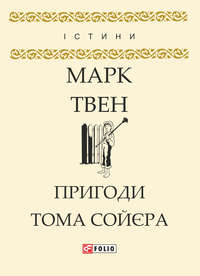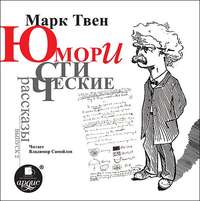 полная версия
полная версияThe Innocents Abroad
From sumptuous Versailles, with its palaces, its statues, its gardens, and its fountains, we journeyed back to Paris and sought its antipodes – the Faubourg St. Antoine. Little, narrow streets; dirty children blockading them; greasy, slovenly women capturing and spanking them; filthy dens on first floors, with rag stores in them (the heaviest business in the Faubourg is the chiffonier’s); other filthy dens where whole suits of second and third-hand clothing are sold at prices that would ruin any proprietor who did not steal his stock; still other filthy dens where they sold groceries – sold them by the half-pennyworth – five dollars would buy the man out, goodwill and all. Up these little crooked streets they will murder a man for seven dollars and dump the body in the Seine. And up some other of these streets – most of them, I should say – live lorettes.
All through this Faubourg St. Antoine, misery, poverty, vice, and crime go hand in hand, and the evidences of it stare one in the face from every side. Here the people live who begin the revolutions. Whenever there is anything of that kind to be done, they are always ready. They take as much genuine pleasure in building a barricade as they do in cutting a throat or shoving a friend into the Seine. It is these savage-looking ruffians who storm the splendid halls of the Tuileries occasionally, and swarm into Versailles when a king is to be called to account.
But they will build no more barricades, they will break no more soldiers’ heads with paving-stones. Louis Napoleon has taken care of all that. He is annihilating the crooked streets and building in their stead noble boulevards as straight as an arrow – avenues which a cannon ball could traverse from end to end without meeting an obstruction more irresistible than the flesh and bones of men – boulevards whose stately edifices will never afford refuges and plotting places for starving, discontented revolution breeders. Five of these great thoroughfares radiate from one ample centre – a centre which is exceedingly well adapted to the accommodation of heavy artillery. The mobs used to riot there, but they must seek another rallying-place in future. And this ingenious Napoleon paves the streets of his great cities with a smooth, compact composition of asphaltum and sand. No more barricades of flagstones – no more assaulting his Majesty’s troops with cobbles. I cannot feel friendly toward my quondam fellow-American, Napoleon III., especially at this time, – [July, 1867.] – when in fancy I see his credulous victim, Maximilian, lying stark and stiff in Mexico, and his maniac widow watching eagerly from her French asylum for the form that will never come – but I do admire his nerve, his calm self-reliance, his shrewd good sense.
CHAPTER XVII
We had a pleasant journey of it seaward again. We found that for the three past nights our ship had been in a state of war. The first night the sailors of a British ship, being happy with grog, came down on the pier and challenged our sailors to a free fight. They accepted with alacrity, repaired to the pier, and gained – their share of a drawn battle. Several bruised and bloody members of both parties were carried off by the police and imprisoned until the following morning. The next night the British boys came again to renew the fight, but our men had had strict orders to remain on board and out of sight. They did so, and the besieging party grew noisy and more and more abusive as the fact became apparent (to them) that our men were afraid to come out. They went away finally with a closing burst of ridicule and offensive epithets. The third night they came again and were more obstreperous than ever. They swaggered up and down the almost deserted pier, and hurled curses, obscenity, and stinging sarcasms at our crew. It was more than human nature could bear. The executive officer ordered our men ashore – with instructions not to fight. They charged the British and gained a brilliant victory. I probably would not have mentioned this war had it ended differently. But I travel to learn, and I still remember that they picture no French defeats in the battle-galleries of Versailles.
It was like home to us to step on board the comfortable ship again and smoke and lounge about her breezy decks. And yet it was not altogether like home, either, because so many members of the family were away. We missed some pleasant faces which we would rather have found at dinner, and at night there were gaps in the euchre-parties which could not be satisfactorily filled. “Moult” was in England, Jack in Switzerland, Charley in Spain. Blucher was gone, none could tell where. But we were at sea again, and we had the stars and the ocean to look at, and plenty of room to meditate in.
In due time the shores of Italy were sighted, and as we stood gazing from the decks, early in the bright summer morning, the stately city of Genoa rose up out of the sea and flung back the sunlight from her hundred palaces.
Here we rest for the present – or rather, here we have been trying to rest, for some little time, but we run about too much to accomplish a great deal in that line.
I would like to remain here. I had rather not go any further. There may be prettier women in Europe, but I doubt it. The population of Genoa is 120,000; two-thirds of these are women, I think, and at least two-thirds of the women are beautiful. They are as dressy and as tasteful and as graceful as they could possibly be without being angels. However, angels are not very dressy, I believe. At least the angels in pictures are not – they wear nothing but wings. But these Genoese women do look so charming. Most of the young demoiselles are robed in a cloud of white from head to foot, though many trick themselves out more elaborately. Nine-tenths of them wear nothing on their heads but a filmy sort of veil, which falls down their backs like a white mist. They are very fair, and many of them have blue eyes, but black and dreamy dark brown ones are met with oftenest.
The ladies and gentlemen of Genoa have a pleasant fashion of promenading in a large park on the top of a hill in the center of the city, from six till nine in the evening, and then eating ices in a neighboring garden an hour or two longer. We went to the park on Sunday evening. Two thousand persons were present, chiefly young ladies and gentlemen. The gentlemen were dressed in the very latest Paris fashions, and the robes of the ladies glinted among the trees like so many snowflakes. The multitude moved round and round the park in a great procession. The bands played, and so did the fountains; the moon and the gas lamps lit up the scene, and altogether it was a brilliant and an animated picture. I scanned every female face that passed, and it seemed to me that all were handsome. I never saw such a freshet of loveliness before. I did not see how a man of only ordinary decision of character could marry here, because before he could get his mind made up he would fall in love with somebody else.
Never smoke any Italian tobacco. Never do it on any account. It makes me shudder to think what it must be made of. You cannot throw an old cigar “stub” down anywhere, but some vagabond will pounce upon it on the instant. I like to smoke a good deal, but it wounds my sensibilities to see one of these stub-hunters watching me out of the corners of his hungry eyes and calculating how long my cigar will be likely to last. It reminded me too painfully of that San Francisco undertaker who used to go to sick-beds with his watch in his hand and time the corpse. One of these stub-hunters followed us all over the park last night, and we never had a smoke that was worth anything. We were always moved to appease him with the stub before the cigar was half gone, because he looked so viciously anxious. He regarded us as his own legitimate prey, by right of discovery, I think, because he drove off several other professionals who wanted to take stock in us.
Now, they surely must chew up those old stubs, and dry and sell them for smoking-tobacco. Therefore, give your custom to other than Italian brands of the article.
“The Superb” and the “City of Palaces” are names which Genoa has held for centuries. She is full of palaces, certainly, and the palaces are sumptuous inside, but they are very rusty without and make no pretensions to architectural magnificence. “Genoa the Superb” would be a felicitous title if it referred to the women.
We have visited several of the palaces – immense thick-walled piles, with great stone staircases, tesselated marble pavements on the floors, (sometimes they make a mosaic work, of intricate designs, wrought in pebbles or little fragments of marble laid in cement,) and grand salons hung with pictures by Rubens, Guido, Titian, Paul Veronese, and so on, and portraits of heads of the family, in plumed helmets and gallant coats of mail, and patrician ladies in stunning costumes of centuries ago. But, of course, the folks were all out in the country for the summer, and might not have known enough to ask us to dinner if they had been at home, and so all the grand empty salons, with their resounding pavements, their grim pictures of dead ancestors, and tattered banners with the dust of bygone centuries upon them, seemed to brood solemnly of death and the grave, and our spirits ebbed away, and our cheerfulness passed from us. We never went up to the eleventh story. We always began to suspect ghosts. There was always an undertaker-looking servant along, too, who handed us a program, pointed to the picture that began the list of the salon he was in, and then stood stiff and stark and unsmiling in his petrified livery till we were ready to move on to the next chamber, whereupon he marched sadly ahead and took up another malignantly respectful position as before. I wasted so much time praying that the roof would fall in on these dispiriting flunkies that I had but little left to bestow upon palace and pictures.
And besides, as in Paris, we had a guide. Perdition catch all the guides. This one said he was the most gifted linguist in Genoa, as far as English was concerned, and that only two persons in the city beside himself could talk the language at all. He showed us the birthplace of Christopher Columbus, and after we had reflected in silent awe before it for fifteen minutes, he said it was not the birthplace of Columbus, but of Columbus’ grandmother! When we demanded an explanation of his conduct he only shrugged his shoulders and answered in barbarous Italian. I shall speak further of this guide in a future chapter. All the information we got out of him we shall be able to carry along with us, I think.
I have not been to church so often in a long time as I have in the last few weeks. The people in these old lands seem to make churches their specialty. Especially does this seem to be the case with the citizens of Genoa. I think there is a church every three or four hundred yards all over town. The streets are sprinkled from end to end with shovel-hatted, long-robed, well-fed priests, and the church bells by dozens are pealing all the day long, nearly. Every now and then one comes across a friar of orders gray, with shaven head, long, coarse robe, rope girdle and beads, and with feet cased in sandals or entirely bare. These worthies suffer in the flesh and do penance all their lives, I suppose, but they look like consummate famine-breeders. They are all fat and serene.
The old Cathedral of San Lorenzo is about as notable a building as we have found in Genoa. It is vast, and has colonnades of noble pillars, and a great organ, and the customary pomp of gilded moldings, pictures, frescoed ceilings, and so forth. I cannot describe it, of course – it would require a good many pages to do that. But it is a curious place. They said that half of it – from the front door halfway down to the altar – was a Jewish synagogue before the Saviour was born, and that no alteration had been made in it since that time. We doubted the statement, but did it reluctantly. We would much rather have believed it. The place looked in too perfect repair to be so ancient.
The main point of interest about the cathedral is the little Chapel of St. John the Baptist. They only allow women to enter it on one day in the year, on account of the animosity they still cherish against the sex because of the murder of the Saint to gratify a caprice of Herodias. In this Chapel is a marble chest, in which, they told us, were the ashes of St. John; and around it was wound a chain, which, they said, had confined him when he was in prison. We did not desire to disbelieve these statements, and yet we could not feel certain that they were correct – partly because we could have broken that chain, and so could St. John, and partly because we had seen St. John’s ashes before, in another church. We could not bring ourselves to think St. John had two sets of ashes.
They also showed us a portrait of the Madonna which was painted by St. Luke, and it did not look half as old and smoky as some of the pictures by Rubens. We could not help admiring the Apostle’s modesty in never once mentioning in his writings that he could paint.
But isn’t this relic matter a little overdone? We find a piece of the true cross in every old church we go into, and some of the nails that held it together. I would not like to be positive, but I think we have seen as much as a keg of these nails. Then there is the crown of thorns; they have part of one in Sainte Chapelle, in Paris, and part of one also in Notre Dame. And as for bones of St. Denis, I feel certain we have seen enough of them to duplicate him if necessary.
I only meant to write about the churches, but I keep wandering from the subject. I could say that the Church of the Annunciation is a wilderness of beautiful columns, of statues, gilded moldings, and pictures almost countless, but that would give no one an entirely perfect idea of the thing, and so where is the use? One family built the whole edifice, and have got money left. There is where the mystery lies. We had an idea at first that only a mint could have survived the expense.
These people here live in the heaviest, highest, broadest, darkest, solidest houses one can imagine. Each one might “laugh a siege to scorn.” A hundred feet front and a hundred high is about the style, and you go up three flights of stairs before you begin to come upon signs of occupancy. Everything is stone, and stone of the heaviest – floors, stairways, mantels, benches – everything. The walls are four to five feet thick. The streets generally are four or five to eight feet wide and as crooked as a corkscrew. You go along one of these gloomy cracks, and look up and behold the sky like a mere ribbon of light, far above your head, where the tops of the tall houses on either side of the street bend almost together. You feel as if you were at the bottom of some tremendous abyss, with all the world far above you. You wind in and out and here and there, in the most mysterious way, and have no more idea of the points of the compass than if you were a blind man. You can never persuade yourself that these are actually streets, and the frowning, dingy, monstrous houses dwellings, till you see one of these beautiful, prettily dressed women emerge from them – see her emerge from a dark, dreary-looking den that looks dungeon all over, from the ground away halfway up to heaven. And then you wonder that such a charming moth could come from such a forbidding shell as that. The streets are wisely made narrow and the houses heavy and thick and stony, in order that the people may be cool in this roasting climate. And they are cool, and stay so. And while I think of it – the men wear hats and have very dark complexions, but the women wear no headgear but a flimsy veil like a gossamer’s web, and yet are exceedingly fair as a general thing. Singular, isn’t it?
The huge palaces of Genoa are each supposed to be occupied by one family, but they could accommodate a hundred, I should think. They are relics of the grandeur of Genoa’s palmy days – the days when she was a great commercial and maritime power several centuries ago. These houses, solid marble palaces though they be, are in many cases of a dull pinkish color, outside, and from pavement to eaves are pictured with Genoese battle scenes, with monstrous Jupiters and Cupids, and with familiar illustrations from Grecian mythology. Where the paint has yielded to age and exposure and is peeling off in flakes and patches, the effect is not happy. A noseless Cupid or a Jupiter with an eye out or a Venus with a fly-blister on her breast, are not attractive features in a picture. Some of these painted walls reminded me somewhat of the tall van, plastered with fanciful bills and posters, that follows the bandwagon of a circus about a country village. I have not read or heard that the outsides of the houses of any other European city are frescoed in this way.
I can not conceive of such a thing as Genoa in ruins. Such massive arches, such ponderous substructions as support these towering broad-winged edifices, we have seldom seen before; and surely the great blocks of stone of which these edifices are built can never decay; walls that are as thick as an ordinary American doorway is high cannot crumble.
The republics of Genoa and Pisa were very powerful in the Middle Ages. Their ships filled the Mediterranean, and they carried on an extensive commerce with Constantinople and Syria. Their warehouses were the great distributing depots from whence the costly merchandise of the East was sent abroad over Europe. They were warlike little nations and defied, in those days, governments that overshadow them now as mountains overshadow molehills. The Saracens captured and pillaged Genoa nine hundred years ago, but during the following century Genoa and Pisa entered into an offensive and defensive alliance and besieged the Saracen colonies in Sardinia and the Balearic Isles with an obstinacy that maintained its pristine vigor and held to its purpose for forty long years. They were victorious at last and divided their conquests equably among their great patrician families. Descendants of some of those proud families still inhabit the palaces of Genoa, and trace in their own features a resemblance to the grim knights whose portraits hang in their stately halls, and to pictured beauties with pouting lips and merry eyes whose originals have been dust and ashes for many a dead and forgotten century.
The hotel we live in belonged to one of those great orders of knights of the Cross in the times of the Crusades, and its mailed sentinels once kept watch and ward in its massive turrets and woke the echoes of these halls and corridors with their iron heels.
But Genoa’s greatness has degenerated into an unostentatious commerce in velvets and silver filagree-work. They say that each European town has its specialty. These filagree things are Genoa’s specialty. Her smiths take silver ingots and work them up into all manner of graceful and beautiful forms. They make bunches of flowers, from flakes and wires of silver, that counterfeit the delicate creations the frost weaves upon a windowpane; and we were shown a miniature silver temple whose fluted columns, whose Corinthian capitals and rich entablatures, whose spire, statues, bells, and ornate lavishness of sculpture were wrought in polished silver, and with such matchless art that every detail was a fascinating study and the finished edifice a wonder of beauty.
We are ready to move again, though we are not really tired yet of the narrow passages of this old marble cave. Cave is a good word – when speaking of Genoa under the stars. When we have been prowling at midnight through the gloomy crevices they call streets, where no footfalls but ours were echoing, where only ourselves were abroad, and lights appeared only at long intervals and at a distance, and mysteriously disappeared again, and the houses at our elbows seemed to stretch upward farther than ever toward the heavens, the memory of a cave I used to know at home was always in my mind, with its lofty passages, its silence and solitude, its shrouding gloom, its sepulchral echoes, its flitting lights, and more than all, its sudden revelations of branching crevices and corridors where we least expected them.
We are not tired of the endless processions of cheerful, chattering gossipers that throng these courts and streets all day long, either; nor of the coarse-robed monks; nor of the “Asti” wines, which that old doctor (whom we call the Oracle,) with customary felicity in the matter of getting everything wrong, misterms “nasty.” But we must go, nevertheless.
Our last sight was the cemetery (a burial place intended to accommodate 60,000 bodies,) and we shall continue to remember it after we shall have forgotten the palaces. It is a vast marble collonaded corridor extending around a great unoccupied square of ground; its broad floor is marble, and on every slab is an inscription – for every slab covers a corpse. On either side, as one walks down the middle of the passage, are monuments, tombs, and sculptured figures that are exquisitely wrought and are full of grace and beauty. They are new and snowy; every outline is perfect, every feature guiltless of mutilation, flaw, or blemish; and therefore, to us these far-reaching ranks of bewitching forms are a hundred fold more lovely than the damaged and dingy statuary they have saved from the wreck of ancient art and set up in the galleries of Paris for the worship of the world.
Well provided with cigars and other necessaries of life, we are now ready to take the cars for Milan.
CHAPTER XVIII
All day long we sped through a mountainous country whose peaks were bright with sunshine, whose hillsides were dotted with pretty villas sitting in the midst of gardens and shrubbery, and whose deep ravines were cool and shady and looked ever so inviting from where we and the birds were winging our flight through the sultry upper air.
We had plenty of chilly tunnels wherein to check our perspiration, though. We timed one of them. We were twenty minutes passing through it, going at the rate of thirty to thirty-five miles an hour.
Beyond Alessandria we passed the battle-field of Marengo.
Toward dusk we drew near Milan and caught glimpses of the city and the blue mountain peaks beyond. But we were not caring for these things – they did not interest us in the least. We were in a fever of impatience; we were dying to see the renowned cathedral! We watched – in this direction and that – all around – everywhere. We needed no one to point it out – we did not wish any one to point it out – we would recognize it even in the desert of the great Sahara.
At last, a forest of graceful needles, shimmering in the amber sunlight, rose slowly above the pygmy housetops, as one sometimes sees, in the far horizon, a gilded and pinnacled mass of cloud lift itself above the waste of waves, at sea, – the Cathedral! We knew it in a moment.
Half of that night, and all of the next day, this architectural autocrat was our sole object of interest.
What a wonder it is! So grand, so solemn, so vast! And yet so delicate, so airy, so graceful! A very world of solid weight, and yet it seems in the soft moonlight only a fairy delusion of frost-work that might vanish with a breath! How sharply its pinnacled angles and its wilderness of spires were cut against the sky, and how richly their shadows fell upon its snowy roof! It was a vision! – a miracle! – an anthem sung in stone, a poem wrought in marble!
Howsoever you look at the great cathedral, it is noble, it is beautiful! Wherever you stand in Milan or within seven miles of Milan, it is visible and when it is visible, no other object can chain your whole attention. Leave your eyes unfettered by your will but a single instant and they will surely turn to seek it. It is the first thing you look for when you rise in the morning, and the last your lingering gaze rests upon at night. Surely it must be the princeliest creation that ever brain of man conceived.
At nine o’clock in the morning we went and stood before this marble colossus. The central one of its five great doors is bordered with a bas-relief of birds and fruits and beasts and insects, which have been so ingeniously carved out of the marble that they seem like living creatures – and the figures are so numerous and the design so complex that one might study it a week without exhausting its interest. On the great steeple – surmounting the myriad of spires – inside of the spires – over the doors, the windows – in nooks and corners – every where that a niche or a perch can be found about the enormous building, from summit to base, there is a marble statue, and every statue is a study in itself! Raphael, Angelo, Canova – giants like these gave birth to the designs, and their own pupils carved them. Every face is eloquent with expression, and every attitude is full of grace. Away above, on the lofty roof, rank on rank of carved and fretted spires spring high in the air, and through their rich tracery one sees the sky beyond. In their midst the central steeple towers proudly up like the mainmast of some great Indiaman among a fleet of coasters.











